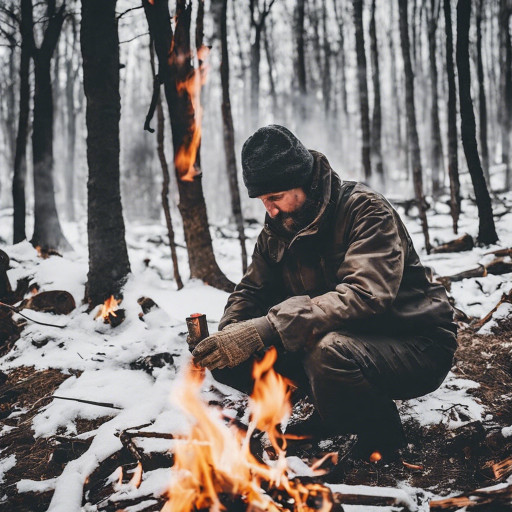Essential Techniques for Successfully Starting Fires in Extreme Cold Weather Conditions
Learning how to effectively start a fire in freezing temperatures is not merely a skill; it is a crucial survival requirement when faced with the harsh realities of winter’s biting chill and persistent winds. For those who are passionate about survival, understanding the indispensable role that fire plays in maintaining body warmth, providing visibility, and enabling food preparation is essential. However, the unique challenges presented by icy environments demand specialized techniques and strategies to overcome them. In this comprehensive guide, we will delve into the most effective methods for successfully creating flames amidst cold weather, empowering you with the skills and knowledge necessary to thrive in the wilderness, even when winter’s frigid grip tightens around you.
Essential Gear for Winter Fire Starting: Equip Yourself for Success
Before you embark on your winter wilderness adventures, it is imperative to prepare by gathering the right gear and supplies that significantly boost your survival odds. A well-prepared fire-starting kit can be the decisive factor in overcoming adverse weather conditions. Ensure that your kit includes the following indispensable items:

a. Firestarters: Essential tools like waterproof matches, storm-resistant lighters, and fire-starting rods are vital for ensuring ignition even under challenging circumstances such as strong winds and wet conditions. By having a variety of reliable options, you’ll gain the confidence needed to start a fire regardless of the obstacles you face.
b. Dry Tinder: Finding dry tinder in frigid temperatures can be a daunting task. To overcome this challenge, pack highly flammable materials such as birch bark, fatwood shavings, and cotton balls infused with petroleum jelly. These materials ignite quickly and significantly improve your chances of successfully starting a fire when the temperature dips below freezing.
c. Kindling: For building a strong foundation for your fire, gather dry sticks, twigs, and leaves. Ensure these materials are entirely devoid of moisture, as any dampness can hinder the ignition process and lead to frustration when trying to spark a flame. Properly prepared kindling is essential for transitioning from tinder to a more robust fire.
d. Fuel: Securing dry firewood in cold conditions can be both exhausting and time-consuming. Therefore, having a sufficient stockpile of dry firewood ready in advance is crucial for maintaining a steady flame over a longer duration, keeping you warm and allowing for comfortable food preparation.
Optimize Your Fire Location: Choosing the Best Spot for Maximum Efficiency
When temperatures drop, selecting the right location for your fire can yield significant benefits. Look for sheltered areas like rock formations or dense shrubbery to minimize exposure to harsh winds. By positioning your fire near a natural windbreak, you not only reduce heat loss but also increase the chances of sustaining a steady flame. Additionally, consider constructing a small wind-resistant shelter using logs or a tarp to protect the fire from precipitation and help retain warmth, ultimately enhancing your comfort and safety in the great outdoors.
Master Layering Techniques for Building Effective and Lasting Fires
One of the most vital techniques for successfully igniting a fire in cold conditions is mastering the art of layering your materials. To build a fire that burns steadily, it is essential to utilize three foundational layers: tinder, kindling, and fuel. Here’s an overview of each layer and its importance:
a. Tinder: The first layer, tinder, consists of materials that ignite quickly and easily. Utilize fine, dry substances like grass, paper, or the previously mentioned birch bark to ensure a robust initial flame. Having an ample supply of tinder is crucial for achieving successful ignition, particularly in cold environments where conditions are less forgiving.
b. Kindling: This layer comprises small sticks and twigs that catch fire swiftly and provide sustained heat. Gradually add kindling to your flame, ensuring there is enough space between pieces to promote airflow and encourage combustion. This step is vital for transitioning from small flames to a larger, more stable fire that can withstand the elements.
c. Fuel: Once a steady flame has been established, gradually introduce larger pieces of firewood. Ensure the wood is dry, as this will burn longer and generate more heat. Increase the size of the wood pieces incrementally, allowing the flames to grow stronger before adding larger logs. This strategic approach to layering your fire facilitates a stable and sustainable flame that can endure even the coldest nights.
The technique of layering your fire creates a structured setup that allows the flames to expand and sustain themselves effectively. Always ensure you have an adequate supply of each component readily available to facilitate a smooth transition from tinder to fuel, thus ensuring a successful fire in challenging conditions.
Enhance Your Fire-Starting Success with Proven Aids and Techniques
In extremely cold weather, leveraging additional fire-starting aids can significantly increase your chances of successfully igniting a fire despite the challenges posed by low temperatures. Here are several effective methods you should consider:
a. Fatwood: Often referred to as nature’s firestarter, fatwood is resin-infused pine wood that ignites easily and burns with intense heat. You can gather these naturally occurring sticks from fallen pine trees or purchase them from outdoor supply stores. Just a few pieces of fatwood can dramatically improve your chances of successfully starting a fire in exceptionally cold conditions.
b. Alcohol-Based Hand Sanitizer: Surprisingly effective, alcohol-based hand sanitizer is highly flammable and serves as an accelerant. Applying a small amount to your tinder or kindling can help ignite a fire rapidly, even in damp weather conditions, simplifying the fire-starting process and ensuring you can stay warm when it matters most.
c. Char Cloth: Char cloth is specially prepared fabric that ignites easily from sparks, making it an excellent tool for starting fires using flint and steel or a lighter in challenging situations. Its lightweight and portable nature makes it an ideal addition to your fire-starting kit, ensuring you are always prepared for whatever conditions arise.
Integrating these fire-starting aids into your cold-weather toolkit can significantly bolster your chances of success when facing particularly challenging environments, allowing you to adapt to the situation effectively.
Explore Effective Fire Techniques Designed for Cold Weather Conditions
As a committed survivalist, continuously refining your skills is crucial to your success. Here are two fire techniques that excel in cold weather conditions:
a. Swedish Torch: Also known as a Canadian Candle or Finnish Fire Log, the Swedish Torch is an exceptionally effective fire-starting method. This technique provides a stable and long-lasting flame, ideal for combating the chill of winter. To create a Swedish Torch, find a log about knee-height and cut several vertical slits along its length. Place tinder in the slits and ignite it. The log will serve as a consistent fuel source, allowing the flame to endure for an extended period, ensuring warmth and safety during your outdoor adventures.
b. Dakota Fire Hole: When faced with strong winds, the Dakota Fire Hole method proves to be highly effective. This technique involves digging a hole and tunneling horizontally underground to create an airflow vent. This design harnesses wind to enhance airflow, resulting in a more efficient fire that is less likely to be disrupted by gusts. Furthermore, the Dakota Fire Hole method effectively reduces visible smoke while conserving fuel, making it an excellent choice for discreet fire building.
Regardless of the method you choose, always prioritize safety and responsible fire management to minimize risks and ensure a successful fire-starting experience.
Successfully igniting a fire in cold weather requires meticulous planning and execution. By following these steps—preparing a reliable fire-starting kit, selecting an appropriate location, mastering layering techniques, utilizing fire-starting aids, and embracing specific fire strategies—you will significantly enhance your chances of success. Remember, practice makes perfect, so consistently train to refine your skills and boost your confidence. With these essential tactics for igniting fires in freezing conditions in your toolkit, you’ll be well-prepared to face even the harshest winters that nature has to offer. Stay warm, prioritize your safety, and keep the flames of survival alive!
The post Fire Starting Methods for Survivalists in Cold Weather appeared first on Survival Bite.
The Article Fire Starting Techniques for Cold Weather Survival Was Found On https://limitsofstrategy.com

